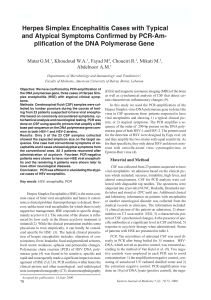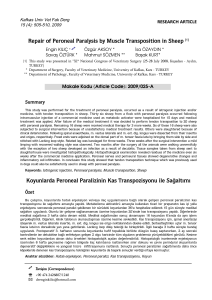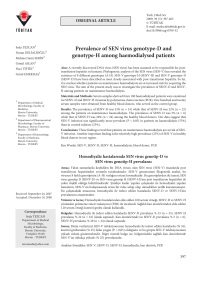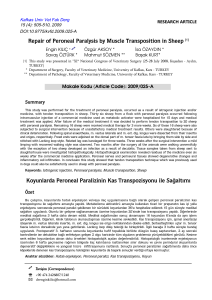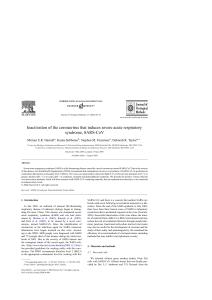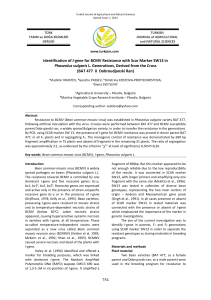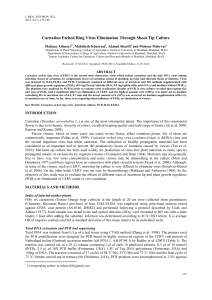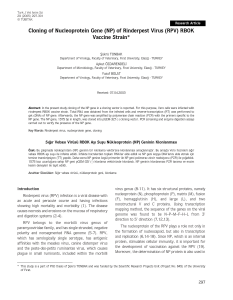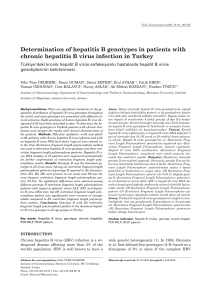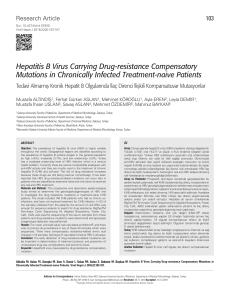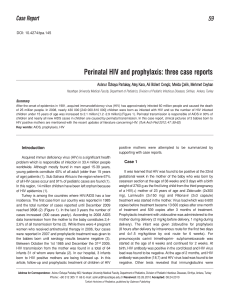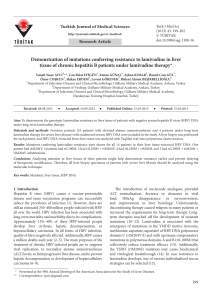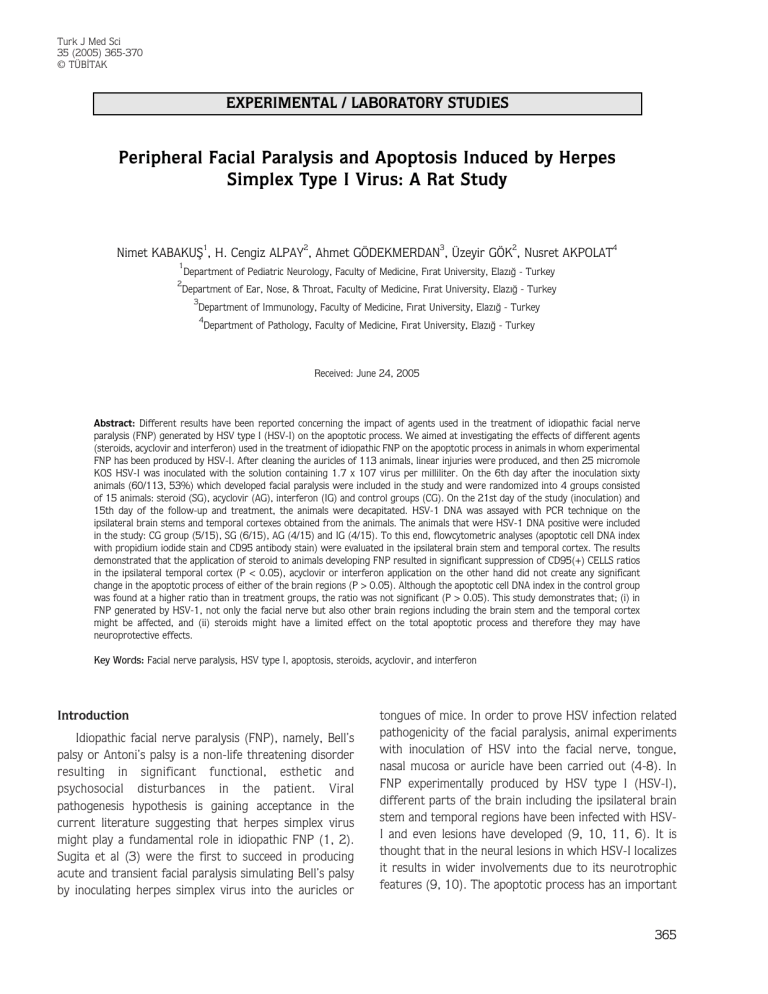
Turk J Med Sci
35 (2005) 365-370
© TÜB‹TAK
EXPERIMENTAL / LABORATORY STUDIES
Peripheral Facial Paralysis and Apoptosis Induced by Herpes
Simplex Type I Virus: A Rat Study
Nimet KABAKUfi1, H. Cengiz ALPAY2, Ahmet GÖDEKMERDAN3, Üzeyir GÖK2, Nusret AKPOLAT4
1
Department of Pediatric Neurology, Faculty of Medicine, F›rat University, Elaz›¤ - Turkey
2
Department of Ear, Nose, & Throat, Faculty of Medicine, F›rat University, Elaz›¤ - Turkey
3
Department of Immunology, Faculty of Medicine, F›rat University, Elaz›¤ - Turkey
4
Department of Pathology, Faculty of Medicine, F›rat University, Elaz›¤ - Turkey
Received: June 24, 2005
Abstract: Different results have been reported concerning the impact of agents used in the treatment of idiopathic facial nerve
paralysis (FNP) generated by HSV type I (HSV-I) on the apoptotic process. We aimed at investigating the effects of different agents
(steroids, acyclovir and interferon) used in the treatment of idiopathic FNP on the apoptotic process in animals in whom experimental
FNP has been produced by HSV-I. After cleaning the auricles of 113 animals, linear injuries were produced, and then 25 micromole
KOS HSV-I was inoculated with the solution containing 1.7 x 107 virus per milliliter. On the 6th day after the inoculation sixty
animals (60/113, 53%) which developed facial paralysis were included in the study and were randomized into 4 groups consisted
of 15 animals: steroid (SG), acyclovir (AG), interferon (IG) and control groups (CG). On the 21st day of the study (inoculation) and
15th day of the follow-up and treatment, the animals were decapitated. HSV-1 DNA was assayed with PCR technique on the
ipsilateral brain stems and temporal cortexes obtained from the animals. The animals that were HSV-1 DNA positive were included
in the study: CG group (5/15), SG (6/15), AG (4/15) and IG (4/15). To this end, flowcytometric analyses (apoptotic cell DNA index
with propidium iodide stain and CD95 antibody stain) were evaluated in the ipsilateral brain stem and temporal cortex. The results
demonstrated that the application of steroid to animals developing FNP resulted in significant suppression of CD95(+) CELLS ratios
in the ipsilateral temporal cortex (P < 0.05), acyclovir or interferon application on the other hand did not create any significant
change in the apoptotic process of either of the brain regions (P > 0.05). Although the apoptotic cell DNA index in the control group
was found at a higher ratio than in treatment groups, the ratio was not significant (P > 0.05). This study demonstrates that; (i) in
FNP generated by HSV-1, not only the facial nerve but also other brain regions including the brain stem and the temporal cortex
might be affected, and (ii) steroids might have a limited effect on the total apoptotic process and therefore they may have
neuroprotective effects.
Key Words: Facial nerve paralysis, HSV type I, apoptosis, steroids, acyclovir, and interferon
Introduction
Idiopathic facial nerve paralysis (FNP), namely, Bell’s
palsy or Antoni’s palsy is a non-life threatening disorder
resulting in significant functional, esthetic and
psychosocial disturbances in the patient. Viral
pathogenesis hypothesis is gaining acceptance in the
current literature suggesting that herpes simplex virus
might play a fundamental role in idiopathic FNP (1, 2).
Sugita et al (3) were the first to succeed in producing
acute and transient facial paralysis simulating Bell’s palsy
by inoculating herpes simplex virus into the auricles or
tongues of mice. In order to prove HSV infection related
pathogenicity of the facial paralysis, animal experiments
with inoculation of HSV into the facial nerve, tongue,
nasal mucosa or auricle have been carried out (4-8). In
FNP experimentally produced by HSV type I (HSV-I),
different parts of the brain including the ipsilateral brain
stem and temporal regions have been infected with HSVI and even lesions have developed (9, 10, 11, 6). It is
thought that in the neural lesions in which HSV-I localizes
it results in wider involvements due to its neurotrophic
features (9, 10). The apoptotic process has an important
365
Peripheral Facial Paralysis and Apoptosis Induced by Herpes Simplex Type I Virus: A Rat Study
contribution in injuries developing in neural tissue. CD95
is an important superficial marker in the triggering and
progression of the apoptotic processes (12, 13).
Different results have been reported concerning the
impact of the agents used in the treatment of idiopathic
FNP on the apoptotic process (14-19). To this end, we
aimed at investigating the effects of different agents
(steroids, acyclovir and interferon) used in the treatment
of idiopathic FNP on the apoptotic process that might
develop in two different regions of the brain (ipsilateral
brain stem and temporal cortex) which have anatomical
and functional similarities with the facial nerve in animals
in whom experimental FNP has been produced by HSV-I.
Material and Methods
Animals and viral inoculation
The study was conducted on 113 female rats each
weighing 190-210 gr after obtaining the approval of
hospital ethics committee. The facial functions of all the
rats were evaluated and the ones with normal facial
functions were recruited in the study. The criteria for
normal facial nerve function were: symmetrical
movements of whiskers during mastication and presence
of eye blinking reflex after blowing pressurized air.
Throughout the study we complied with the principles of
experimental and surgical techniques in rats.
The HSV type-I (KOS strain) was used in our study.
Solutions containing the virus were prepared by having
7
1.7 x 10 virus per milliliter of the solution (22). Before
the inoculation, all the animals were injected with
87mg/kg ketamin hydrochloride (Ketalar, Eczacıbaflı,
Turkey) and 13mg/kg xylazine hydrochloride (Rompun,
Bayer, Turkey) intraperitoneally for anesthesia. After
cleaning their auricles with 70% ethyl alcohol and drying,
linear injuries were produced with a sterile technique
using a 27 gauge needle. Then, 25 micromole KOS HSV
Type I was inoculated into the injured site with the
7
solution containing 1.7 x 10 virus per milliliter. After the
inoculation, facial functions of the animals were evaluated
three times a day. On the 6th day after the inoculation 60
animals (60/113, 53%) had unilateral loss of the whisker
movements on the right, they were not able to close their
eyes on the same side and the presence of these findings
resulted in the diagnosis of peripheral facial paralysis.
Clinically generated FNP was also evaluated
electrophysiologically. For this purpose, one animal from
366
the treatment and one from the control group were given
general anesthesia. Afterwards, the facial nerve was
stimulated both on the affected right side and the intact
left side at the point where it left the stylomastoid
foramen. Muscle amplitudes that were generated and the
response rates to the stimuli verified the diagnosis of
FNP.
The animals that developed facial paralysis were
included in the study and were randomized into groups.
Each group consisted of 15 animals. These were steroid,
acyclovir, interferon and control groups: Group 1Control Group (CG): The animals in this group received 1
ml/kg intramuscular equal volume of physiologic saline.
Group 2- Steroid Group (SG): the animals in this group
received 1mg/kg intramuscular methyl prednisolone
succinate once a day. Group 3- Acyclovir Group (AG): the
animals in this group were weighed every day and total
acyclovir dose of 5mg/kg was given intraperitoneally in 5
equal portions at equal time intervals. Group 4Interferon group (IG): the animals in this group received
100.000 unit/kg interferon ?-2b intramuscularly every
other day.
Perfussion and tissue preparetions
st
th
On the 21 day of the study (inoculation) and 15 day
of the follow-up and treatment, following the
administration of high dose anesthetic substances, after
the achievement of loss of consciousness, the animals
were decapitated with a guillotine system providing
decapitation with a single movement. HSV-1 DNA was
assayed with the PCR technique on the ipsilateral brain
stems and temporal cortexes obtained from the animals.
The animals that were HSV-1 DNA positive were included
in the study. There were five such animals in CG (5/15),
six in SG (6/15), four in AG (4/15) and 4 in IG (4/15).
Afterwards, the apoptosis study was initiated. The cell
suspension was prepared as follows. Tissue samples were
transferred into Petri dishes and pellets were formed.
Pellets were then transferred into test tubes containing
EDTA and 1.8 ml of trypsin was added. The prepared
o
material was kept in a 37 C water bath for 7 minutes.
The supernatant above the pellet was taken with a
Pasteur pipette kept adjacent to the surface of the pellet.
It was then centrifuged at 1250 rpm for 5 minutes. The
supernatant was resuspended with 2 ml PBS and
centrifuged twice. The supernatant was discarded with a
Pasteur pipette. 0.5 ml of PBS was added and it was
N. KABAKUfi, H. C. ALPAY, A. GÖDEKMERDAN, Ü. GÖK, N. AKPOLAT
filtered through a 40 micron filter. 100 microliter of an
aliquot was taken from the prepared sample and mixed
with 20 microliter of CD95 antibody stain (CD95,
Beckman Coulter CD95 monoclonal antibody kit) in a test
tube and kept at room temperature for 20 minutes in a
dark environment. It was then assayed with flow
cytometry with a relevant program.
Propidium iodide stain and flowcytometric
analysis
For the DNA study, the filtered sample was mixed
with 1 ml of 0.5% formalin for fixation and was kept at
room temperature for 10 minutes. 100 microliter of the
prepared sample was mixed with 10 microliter of
propidium iodide (PI) and kept at room temperature for
20 minutes in the dark. It was then assayed with flow
cytometry with a relevant program. COULTER Epics XLMCL device EXPO 32 program utilizes PI stain (FlowTACS
Apoptosis Detection Kit: Catalog number TA5354, R&D
Systems, USA) for DNA analysis that fluoresces at 617
nm, linear signals were thus counted with the FL3
detector. First, control group samples were passed
through the device, apoptotic and singlet cells were taken
into two separate gates, doublet cells were left out of the
gates. Peaks pertaining to apoptotic DNA fragments
appeared between 0-200, therefore voltage adjustment
was performed to have the X mean value of the peak at
200 for FL3 histogram. Samples were counted by using
the same voltage adjustments.
Statistical analyses were carried out with the SPSS
computer program (SPSS Inc, USA). Mean and standard
errors of all the data were calculated.
Results
Facial nerve paralysis and HSV-1 DNA positivity
The study was completed in 19 animals (CG: n=5,
33%; SG: n=6, 40%; AG: n=4, 27% and IG: n=4, 27%)
which were found to have developed FNP together with
HSV-1 DNA positivity of the brain stem and temporal
cortex and had inflammatory lesions in the
histopathological examination. The ratio of HSV-1 DNA
positivity in the cerebral regions of the control and
treatment groups was not of statistical significance (P >
0.05).
Facial nerve paralysis, CD95(+) cells and apoptotic
DNA index
The results demonstrated that the application of
steroid to animals developing FNP resulted in significant
suppression of CD95 (+) cells ratios in the ipsilateral
temporal cortex (P < 0.05) (Table 1), acyclovir or
interferon application on the other hand did not create
any statistically significant change in the apoptotic process
of either of the brain regions (P > 0.05). Also, with
steroid treatment CD95 (+) cells ratios in the brain stem
were mildly suppressed (CG: 26.6 ± 3.1 vs SG: 20.0 ±
1.4 and AG: 22.1 ± 3.6).
The results of propidium iodide stain and
flowcytometric analysis were summarized in Table 1.
Although the apoptotic cell DNA index (apoptotic cell DNA
/ total cell DNA) in the control group was found at a
higher ratio than in treatments groups, the ratio was not
significant (P > 0.05).
Table 1. The extent of CD95 and apoptotic DNA index in the groups (mean ± SD).
CD95 (%)
DNA index (%)
Neural cells /
Ipsilateral
Ipsilateral
Ipsilateral
Ipsilateral
Groups
brain stem
temporal
brain stem
temporal
Control
26.6 ± 3.1
30.6 ± 2.9*
25.9 ± 3.9
29.0 ± 1.3
Steroid
20.0 ± 1.4
17.5 ± 0.4*
23.4 ± 3.8
25.5 ± 1.9
Acyclovir
22.1 ± 3.6
33.2 ± 1.5
21.5 ± 3.2
25.0 ± 1.6
Interferon
26.6 ± 3.5
25.2 ± 4.1
23.7 ± 5.9
24.8 ± 3.7
*P < 0.05
367
Peripheral Facial Paralysis and Apoptosis Induced by Herpes Simplex Type I Virus: A Rat Study
Discussion
In different neural damages produced by HSV, not
only the specific tissue but also adjacent and even nonadjacent cerebral tissues might be damaged. Similarly,
our study revealed that in FNP generated by HSV-1, not
only the facial nerve but also other brain regions including
the brain stem and the temporal cortex were affected
(9,10,11). In a study conducted by Ishii et al (6) nasal
mucosa, tongue, oral muscles and auricular canal of the
animals were infected with HSV-1; despite the fact that
FNP did not develop, HSV related antigens have been
isolated from facial nerve, trigeminal ganglia and pons;
furthermore, these regions have demonstrated
inflammatory
cellular
response,
hemorrhage/
degeneration and necrosis. This invasion of HSV-1 to
more distant regions than the locally inoculated regions
and its potential to create neural damage in those regions
is mostly due to the neurotropic features of the virus
(20).
One of the pathological processes initiated by HSV-1
in the neural tissue is the apoptotic damage (11, 17, 21).
If the neuronal apoptotic process induced by HSV-1 can
be suppressed by certain medications, this damage can be
prevented to a certain extent.
Treatment in FNP should be based on the underlying
pathophysiology. Studies on T and B lymphocytes (22,
23), immune complexes (24, 25), cerebrospinal fluid (4,
26, 27) and serum interferon levels (28) in patients with
Bell’s palsy suggest that the disease process might be a
cellular immune response to a viral inflammatory process.
If so, steroid treatment would be appropriate. Such
treatment has already proved effective (29, 30, 31).
CD95 has been shown to mediate receptor dependent
programmed cell death and to be expressed in the
nervous system (12). It is now being recognized that
CD95 signaling by immune cells mediates effects other
than apoptosis (11, 12). In our study, amongst the
medications shown to have positive effects on FNP
treatment, only steroids were shown to suppress CD95
(+) cells ratios in the ipsilateral temporal cortex. In the
studies that were carried out, in addition to the healing
process of FNP (13), steroids were shown to have a
368
neuronal anti-apoptotic effect (14-16, 32). Furthermore,
with steroid treatment CD95 (+) cells ratios in the brain
stem were mildly suppressed, the situation being
reflected in the apoptosis rates of both regions. This
condition demonstrates that, in neural damage generated
by HSV-1, steroids might have a limited effect in the total
apoptotic process. The steroids were shown to exert their
effects by increasing the expression of calbidin-D (CALB)
which has neuro-protective effects (16) and by inhibiting
the influx of calcium into the cell (32).
The results of the studies on the effects of acyclovir
and interferon on FNP are controversial (17,18,19,21).
Acyclovir is reported to have no effect on the apoptotic
process on HSV-1 induced neuronal damage (17, 21),
Interferon on the other hand might influence this process
depending on the subtypes (18, 19). In our study, these
two agents were not shown to have any effect on the
apoptotic process in the neural damage accompanying
FNP.
HSV-1 is known to be related to several
neuropathological conditions (hemorrhagic encephalitis,
FNP, chronic encephalitis, epileptogenic neural
transformation) (33). Wu et al (34) reported that
inoculation of HSV-1 to corneas of mice induced acute
spontaneous behavioral and electrophysiological seizures
and chronically increased hippocampal excitability
together with susceptibility to seizures. HSV-1 induced
FNP can also result in similar neuropathological
conditions. Because of such possibilities, all HSV-1
induced neural lesions should preferably be treated and
their long term follow-up would be crucial for the general
health of the patient.
Corresponding author:
Nimet KABAKUfi
Fırat University,
Faculty of Medicine,
Department of Pediatric Neurology,
23119 Elazı¤ - Turkey
E-mail: [email protected]
N. KABAKUfi, H. C. ALPAY, A. GÖDEKMERDAN, Ü. GÖK, N. AKPOLAT
References
1.
Vahlne A, Edstrom S, Arstila P et al. Bell’s palsy and herpes
simplex virus. Arch Otolaryngol 107:79-81, 1981.
2.
Liston SL, Kleid MS. Histopathology of Bell’s palsy. Laryngoscope
99:23-6, 1989.
3.
Sugita T, Murakami S, Yanagihara N et al. Facial nerve paralysis
induced by herpes simplex virus in mice: an animal model of acute
and transient facial paralysis. Ann Otol Rhinol Laryngol 104:5748, 1995.
4.
Kumagami H. Experimental facial nerve paralysis. Arch
Otolaryngol 95:305-12, 1972.
5.
Ishii K, Kurata T, Nomura Y. Experiments on herpes simplex viral
infections of the facial nerve in the tympanic cavity. Eur Arch
Otorhinolaryngol 247:165-7, 1990.
6.
Ishii K, Kurata T, Sata T et al. An animal model of type-1 herpes
simplex virus infection of facial nerve. Acta Otolaryngol 446:15764, 1988.
17.
Shaw MM, Gurr WK, Thackray AM et al. Temporal pattern of
herpes simplex virus type 1 infection and cell death in the mouse
brain stem: influence of guanosine nucleoside analogues. J Virol
Methods 102:93-102, 2002.
18.
Ling Z, Van de Casteele M, Dong J et al. Variations in IB1/JIP1
expression regulate susceptibility of beta-cells to cytokine-induced
apoptosis irrespective of C-Jun NH2-terminal kinase signaling.
Diabetes 52:2497-502, 2003.
19.
Chan A, Seguin R, Magnus T et al. Phagocytosis of apoptotic
inflammatory cells by microglia and its therapeutic implications:
termination of CNS autoimmune inflammation and modulation by
interferon-beta. Glia 43:231-42, 2003.
20.
Rogers JH, Rhodes K, Roberts S et al. A herpes virus vector can
transduce axotomized brain neurons. Exp Neurol 183:548-58,
2003.
21.
Shaw MM, Gurr WK, Watts PA et al. Ganciclovir and penciclovir,
but not acyclovir, induce apoptosis in herpes simplex virus
thymidine kinase-transformed baby hamster kidney cells. Antivir
Chem Chemother 12:175-86, 2001.
22.
Aviel A, Ostfeld E, Burstein R et al. Peripheral blood T and B
lymphocyte subpopulations in Bell’s palsy. Ann Otol Rhinol
Laryngol 92:187-91, 1983.
23.
Bumm P, Schlimok G. T-lymphocyte subpopulations and HLA-DR
antigens in patients with Bell’s palsy, hearing loss, neuronitis
vestibularis, and Meniere’s disease. Eur Arch Otorhinolaryngol
25:447-8, 1994.
24.
Bumm P, Schlimok G. Lymphocyte subpopulations and HLA-DR
determinations in diseases of the inner ear and Bell’s palsy. HNO
34:525-7, 1986.
25.
Abramsky O, Webb C, Teitelbaum D et al. Cell-mediated immunity
to neural antigens in idiopathic polyneuritis and myeloradiculitis.
Clinical-immunologic classification of several autoimmune
demyelinating disorders. Neurology 25:1154-9, 1975.
7.
Thomander L, Aldskogius H, Vahlne A et al. Invasion of cranial
nerves and brain stem by herpes simplex virus inoculated into the
mouse tongue. Ann Otol Rhinol Laryngol 97:554-8, 1988.
8.
Hill TJ, Field HJ, Blyth WA. Acute and recurrent infection with
herpes simplex virus in the mouse: a model for studying latency
and recurrent disease. Virology 28:341-53, 1975.
9.
Watanabe D, Honda T, Nishio K et al. Corneal infection of herpes
simplex virus type 2—induced neuronal apoptosis in the brain
stem of mice with expression of tumor suppressor gene (p53)
and transcription factors. Acta Neuropathol 100:647-53, 2000.
10.
Valyi-Nagy T, Olson SJ, Valyi-Nagy K et al. Herpes simplex virus
type 1 latency in the murine nervous system is associated with
oxidative damage to neurons. Virology 278:309-21, 2000.
11.
Qian H, Atherton S. Apoptosis and increased expression of Fas
ligand after uniocular anterior chamber (AC) inoculation of HSV1. Curr Eye Res 26:195-203, 2003.
12.
Becher B, Barker PA, Owens T et al. CD95-CD95L: can the brain
learn from the immune system? Trends Neurosci 21:114-7,
1998.
26.
Djupesland G, Berdal P, Johannessen TA et al. Viral infection as a
cause of acute peripheral facial palsy. Arch Otolaryngol 102:4036, 1976.
13.
Wang J, Charboneau R, Barke RA et al. Mu-opioid receptor
mediates chronic restraint stress-induced lymphocyte apoptosis. J
Immunol 169:3630-6, 2002.
27.
Edstrom S, Hanner P, Andersen O et al. Elevated levels of myelin
basic protein in CSF in relation to auditory brainstem responses in
Bell’s palsy. Acta Otolaryngol 103:198-203, 1987.
14.
Cardenas SP, Parra C, Bravo J et al. Corticosterone differentially
regulates bax, bcl-2 and bcl-x mRNA levels in the rat
hippocampus. Neurosci Lett 331:9-12, 2002.
28.
Jonsson L, Alm G, Thomander L. Elevated serum interferon levels
in patients with Bell’s palsy. Arch Otolaryngol Head Neck Surg
115:37-40, 1989.
15.
Nagai T, Noda Y, Nozaki A et al. Neuroactive steroid and stress
response. Nihon Shinkei Seishin Yakurigaku Zasshi 21:157-62,
2001.
29.
Adour KK, Wingerd J, Bell DN et al. Prednisone treatment for
idiopathic facial paralysis (Bell’s palsy). N Engl J Med 287:126872, 1972.
16.
Stuart EB, Thompson JM, Rhees RW et al. Steroid hormone
influence on brain calbindin-D (28K) in male prepubertal and
ovariectomized rats. Brain Res Dev Brain Res 129:125-33, 2001.
30.
Taverner D, Cohen SB, Hutchinson BC. Comparison of
corticotrophin and prednisolone in treatment of idiopathic facial
paralysis (Bell’s palsy). Br Med J 4:20-2, 1971.
369
Peripheral Facial Paralysis and Apoptosis Induced by Herpes Simplex Type I Virus: A Rat Study
31.
Austin JR, Peskind SP, Austin SG et al. Idiopathic facial nerve
paralysis: a randomized double blind controlled study of placebo
versus prednisone. Laryngoscope 103:1326-33, 1993.
33.
Ben-Hur T, Cialic R, Weidenfeld J. Virus and host factors that
mediate the clinical and behavioral signs of experimental herpetic
encephalitis. Acta Microbiol Immunol Hung 50:443-51, 2003.
32.
Karst H, Joels M. Calcium currents in rat dentate granule cells are
altered after adrenalectomy. Eur J Neurosci 14:503-12, 2001.
34.
Wu HM, Huang CC, Chen SH et al. Herpes simplex virus type 1
inoculation enhances hippocampal excitability and seizure
susceptibility in mice. Eur J Neurosci 18:3294-304, 2003.
370

